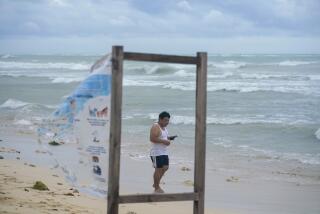Death Toll, Strife Grow in Pauline’s Wake
- Share via
ACAPULCO, Mexico — Some soldiers dug bodies from under cars while others served steaming meals to hurricane survivors Friday as hundreds of thousands of Mexicans struggled to recover from the country’s worst natural disaster in nearly a decade.
The cleanup effort was complicated by a fresh curtain of driving rain and by washed-out bridges and mounds of dirt blocking roads leading to disaster sites. The death toll from Thursday’s brutal storm continued to mount, with the Mexican Red Cross confirming 137 dead but warning that the total could reach 400. The number of homeless people in Guerrero state was estimated at as many as 50,000 people, authorities said.
Thousands were injured in the coastal states of Oaxaca and Guerrero, which includes Acapulco. More than 40,000 homes in the two states were damaged or destroyed, state officials said.
About 6,500 soldiers aided hurricane survivors and dug out bodies still buried under mud, homes, water and debris in both states.
Hundreds of military nurses and doctors were dispatched to the area to help the sick and wounded, officials said.
In addition, 200 tons of relief supplies--food, medicine and clothing--have been sent to the coast, the Red Cross said.
“We are moved to see the sensational response. People have even been arriving in taxis with donations,” said Jose Barroso, president of the Mexican Red Cross.
Pauline was downgraded to tropical storm status Thursday and was dissipating Friday.
On Acapulco’s famous Costera Miguel Aleman, an oceanfront boulevard lined with resort hotels and boutiques, a handful of tourists mingled incongruously with olive-uniformed soldiers shoveling mud Friday. Tourist hotels, however, survived the storm mostly unscathed.
But the brunt of Hurricane Pauline was borne by poor residents, many of whom lived in flimsy houses that were swept down ravines when the torrential rains struck.
“Nothing like this has ever happened. We’re left with no home--nothing,” said a dazed Yenet Chavez, a 22-year-old mother clutching her baby son at a government food warehouse that has been converted into a shelter.
She and six relatives had been listening nervously to the storm at dawn Thursday in her mud-and-stone house when they suddenly heard a loud roar, she recalled.
“The mountain collapsed on top of our house,” she said. “The back wall gave way. . . . Everything filled with water and mud.”
The family managed to flee.
Others were not so lucky. Maria Ofelia Lopez, 41, sat stonily outside a government office where bodies were being brought Friday morning. She had seen her husband and 24-year-old son swept away the day before by a torrent that had crashed into their wooden home, wrecking the building.
But despite going from hospital to Red Cross office to morgue for the entire night, she’d found no sign of her loved ones. “They can’t be alive,” she said quietly. “They were swept away with huge rocks.”
Rocks the size of television sets littered many Acapulco streets. Cars stuck up at 45-degree angles from waist-high mounds of dirt. As bulldozers pushed away piles of earth, fresh rain filled streets anew. Despite the pelting downpour, soldiers and other relief workers stepped up the search for bodies.
In a carport in one middle-class neighborhood, soldiers doggedly shoveled away calf-high mud from around a red Ford Escort. From under the car appeared a tiny foot. It belonged to a dead child, apparently swept under the vehicle by a river of mud.
A soldier leading the excavation said his unit had earlier plucked the body of a middle-aged man from a tree near the second-floor porch of a house. The soldiers also had discovered a little girl’s body nestled against some tree trunks in a stream, he said.
But he said the soldiers had barely begun to tackle the piles of rocks, palms and sheet-metal that had been homes and now could be tombs.
Struggling to aid the thousands of new homeless, the government distributed food, medicine, blankets and used clothing at dozens of shelters in Acapulco and Oaxaca. Soldiers dished up hot chicken and rice for victims at a homeless shelter in a basketball stadium in the poor Renacimiento (Renaissance) neighborhood.
Most people there had only the clothes on their backs; one woman could not even grab a diaper as she fled her collapsing house. Her 1-year-old was naked from the waist down.
Even many whose homes had survived were desperate.
Outside the Renacimiento shelter, hundreds of other residents lined up hoping the government would distribute food to them as well--though there was no evidence of such a program.
Sara Zabaleta, a 47-year-old widow, said she had lost the last of her $94-a-month pension check, her only income, when the raging flood waters swept away her purse.
“We came to see if they’ll give us food packages,” she said. “We have nothing.”
Relief efforts went slowly. In Oaxaca, at least 10 bridges and many major roads were washed out.
“The communities are being reached by whatever means are available--with horses, donkeys and by foot,” said Blanca Cervera, an official at the Oaxaca state government office in Mexico City.
President Ernesto Zedillo, who cut short his European tour, said in Germany on Friday that “lamentably, there will probably be more deaths” recorded.
About 70% of Acapulco was still without water Friday afternoon, and residents complained that shop owners were jacking up the prices of what was available.
The scarcity of water prompted health officials to issue a plea for antibiotics and other medical supplies, anticipating widespread sickness as a result of people drinking contaminated water.
Robert Randolph of The Times’ Mexico City Bureau contributed to this report.
More to Read
Sign up for Essential California
The most important California stories and recommendations in your inbox every morning.
You may occasionally receive promotional content from the Los Angeles Times.













